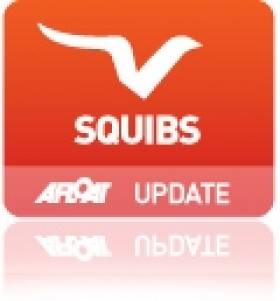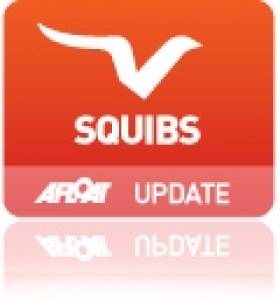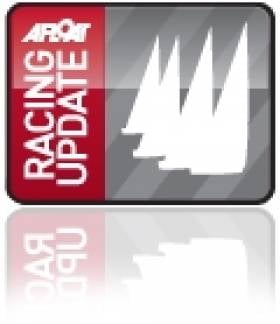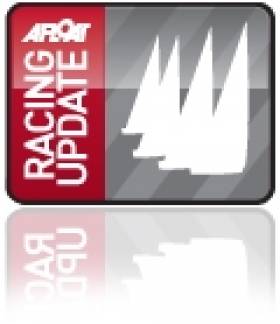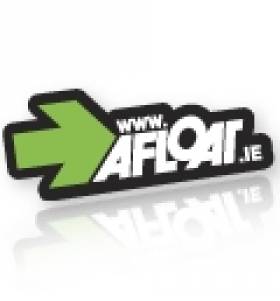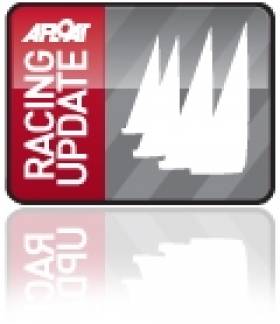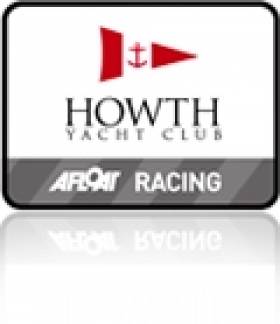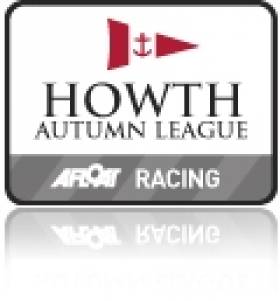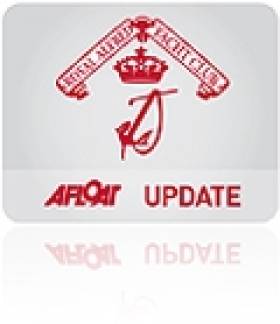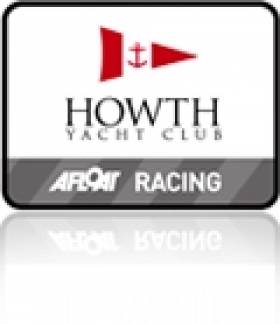Displaying items by tag: squib
Royal St. George Pair Lead Irish Squib Championship (Photos Here!)
#squib – Vincent Delany and Fergal Gaynor sailing Femme Fatale are in charge after the first day's racing of the Irish National Squib championships on Dublin Bay. Scroll down for photos from Gareth Craig below. The Royal St. George YC paring have established a lead of six points after thre the first three races. Kinsale visitors Marcus and Megan Hutchinson are second on 15 points. Third is another local pairing Aidan O'Connell and Ben O'Donoghue Provisional Day one results subject to protest are posted below as a pdf for download.
Irish Squib Nationals Shapes up for Closest Contest in Years
#squib – There is an unwritten tradition that the Irish Championship is always won by a Northern boat but perhaps 2012 is the year for a winner from Kinsale, Howth or Dun Laoghaire? The Irish National Championships is to be held from 25th to 27th August at the Royal St. George Yacht Club, which is conveniently located almost equidistant from the main centres of Squib racing at Wexford, Kinsale, Glandore, Mayo, Belfast Lough and Strangford Lough.
Already in 2012 we have had two regional championships which produced very different results. The South Coast Championship in Kinsale with a fleet of 17 boats was won by husband and wife team- Marcus and Meghan Hutchinson from the home club in 'Sensation'. Second was James and Bruce Matthews in 'Mucky Duck' also from Kinsale. Third place was taken by the consistent 'Toy for the Boys' sailed by Peter Wallace and Kerry Boomer from Royal North of Ireland Yacht Club. None of the Dublin boats featured in the results.
The Northern Championship in Killyleagh Sailing Club on Strangford Lough in June with a fleet of 21 was won by Inis'allagh steered by David Eccles and Philip Hutchinson from Royal North of Ireland, second was Gordon Patterson and Ross Nolan in 'Quickstep' from the same club, with Brian O'Hare and Tonya Mc.Allister in 'Nimble' from Royal St. George in Dun Laoghaire in third place.
At the U.K. National Championships in Dartmouth in July the best Irish boat was husand and wife Johnathan Craig and Hazel Ruane in 'Kerfuffle' followed by Vincent Delany and Fergal Gaynor in 'Femme Fatale'.
This should be one of the most open Irish Squib Championships for years.
A Squib keelboat is a modest two man sailing boat, almost 6m. long but with a small sail area. It was designed some 40 years ago and retains its popularity with more than 870 boats throughout Britain and Ireland.
#RACING ROUND–UP – Ireland's Star pair Peter O'Leary and David Burrows are in the frame at the Star worlds in Hyeres this morning having held the lead after thie first two races, James Espey is Olympic bound in his Laser dinghy following qualification in Germany last night, Alexander Rumball and Rory McStay are joining the Irish ISAF Youth Worlds squad as Ireland's first Catamaran pairing, Offshore J109s continue to dominate on the Irish Sea and ICRA is still seeking support to mount a defence of its 2010 Commodore's Cup victory.
Kinsale's Marcus Hutchinson won the South Coast Squibs, JP McCaldin was on form at the J24 Easterns in Howth, Derek Mitchell was top in Saturday's DBSC Ruffian race, Foynes Yacht Club cruised to Limerick and Andrew Algeo emerged a winner in a class that have changed much more than their racing format.
Kinsale Sailors Win South Coast Squib Title
#SQUIB – Marcus and Meagan Hutchinson sailing 'Sensation' won a heavy air South Coast Squib keelboat championships in Kinsale on Sunday. Big swells and 20–knot easterly winds led to many retirals in the 17-boat fleet. Second overall were James and Bruce Matthews followed by Peter Wallace and Kerry Boomer from Royal North Ireland Yacht Club.
Six races were sailed with one discard.
| Series Place | Sail No | Boat | Helm | Crew | Club | Series Points |
|---|---|---|---|---|---|---|
| 1 | 523 | Sensation | Marcus Hurchinson | Meghan Hutchinson | KYC | 5 |
| 2 | 51 | Mucky Duck | James Matthews | Bruce Matthews | KYC | 6 |
| 3 | 818 | Toy for The Boys | Peter Wallace | Kerry Boomer | RNIYC | 12 |
| 4 | 667 | Servus | Bobby Conlon | Daz | MAYO SC | 22 |
| 5 | 150 | Espresso | Victor Fusco | Ben Fusco | KYC | 22 |
| 6 | 820 | Quick Step | Gordon Patterson | Lindsay Nolan | RNIYC | 25 |
| 7 | 548 | Yacht Services Ireland | Colm Dunne | Rob Gill | KYC | 26 |
| 8 | 83 | Nebulette | Dave Matthews | Katie Matthews/Dave Power | KYC | 27 |
| 9 | 729 | Mack | Paul McCarthy | Dunocha Kiely | KYC | 35 |
| 10 | 79 | Sedition | Cian O'Regan | Dominic Falvey | KYC | 41 |
| 11 | 497 | Samphire | Joe Connell | Jez Gibson | KYC | 48 |
| 12 | 46 | Lola | Frank Whelan | Brian Hare | DUBLIN BAY | 49 |
| 13 | 528 | Chocoholic | Sarah-Louise Rossiter | Ian Rossiter | WEXFORD HARBOUR | 51 |
| 14 | 700 | Serendipity | Michael Field | Declan Fox | KYC | 53 |
| 15 | 344 | Chuckle | Michael Jones | Andrew Bellingham | WEXFORD HARBOUR | 63 |
| 16 | 348 | Lucy Jayne | Graham Files | Mary Moore | WEXFORD HARBOUR | 66 |
| 17 | 711 | Rebel | Gemma Twohig | Tom Twohig | KYC | 73 |
Squib Racing Keelboat is for sale
A 1978 Squib called Pegasus that has a new mast, new running rigging and new standing rigging is for sale on the Afloat Boats for Sale site at €4,950. The Squib is an active racing class in Ireland and this example appears to be' ready to race'. She's complete with a Silva Mast compass, braked road trailer, deck cover and new Dick Batt Pink Spinnaker. All the details on our boats for sale site here.
Tight Competiton for Squibs, SB3s and Elites at Royal North
Royal North of Ireland Yacht Club has completed its keelboat fixture sponsored by Brewin Dolphin consisting of three fleets; RS Elites, SB3s and Squibs, racing six races over two days. The RS Elites was the joint largest fleet this year made up mostly of local boats and two visiting Elites from Ocean Youth Trust. The Squibs were next in numbers, followed by The SB3s.
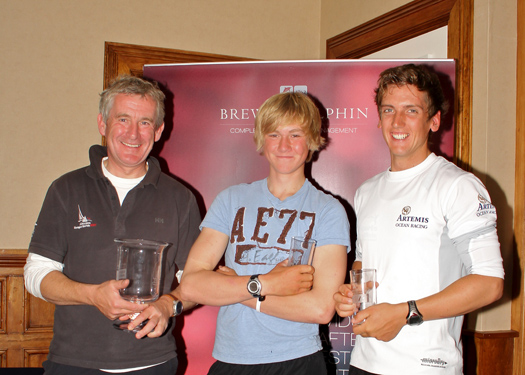
RS Elite Class Winners Simon Brien, Jack Brien and Ryan Seaton
Simon Brien on "Kin" was to rule the Elite class, and he found he was going to have to fight for it. On Day one, his brother Mark on "Full Marks" was covering him tack for tack and very little separated them on all three races. John McDowell' "Sea Breezes" [From Carrick] was also on the pace and finished the day one point behind "Kin". Bob Espey and Matt McGovern [Ballyholme] on an Ocean Youth Trust Boat was also consistently at the top of the fleet.
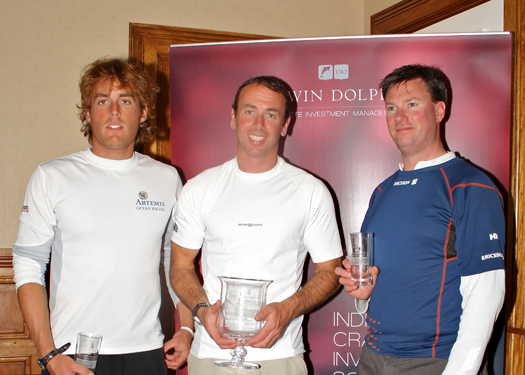
SB3 Class Winners Gareth Flannigan Ross Nolan and James Espey
The SB3 fleet also had it tight, day one saw a battle between Gareth Flannigan on "Splash Gordon" with James Espey and Ross Nolan on board match race with Peter Kennedy on "Ridge Fence" both boats finishing the day on equal points, followed closely by Trevor Darcy and Andrew Vaughan on "Bullet" on 8 points. On the Squibs, Greg Bell was out to flex his mussels on his new Squib "Prodigal" against him was Sam Lyness on "Worm" and Peter Wallace on "Toy for the Boy". The first race went to "Worm" with "Toy for the Boy second and "Prodigal" third, however a later protest was to knock "Worm" of her top spot and allowed everyone else to slide up one place. Race two also went to "Worm" followed by "Prodigal" and "High Flyer" in third. The third race again saw a change in the top spot this time "Toy for the Boy" taking pole. By the days end yet another fleet had two boats tied on points for the top spot, "Prodigal" and "Toy". Sundays racing was postponed for an hour to allow for the wind to fill in, and this was welcomed by many of the competitors due to lots of revelry the night before.
A fresh southerly breeze filled in and allowed Principle Race Officer Neale McCullough to get racing under way. Royal North's Commodore Mike Vaughan took race four in the Elite Fleet with "Kin" second and "Full Marks" third.
The fifth race "Kin" was back to her number one slot with the Vaughan's second and Andrew Allen's "No Match" third. The last race in the Elite fleet had to be seen to be believed as each boat tacked up the beat, each boat having to dip a boat that had dipped them on the previous tack and vice versa, by the top mark an d spreader mark they were bumper to bumper only a few inches separating them they looked like a train!
Eventually Simon Brien's "Kin" took the line honours and the series followed by Mike Vaughan's 64 and John McDowell's "Sea Breezes" in third overall.
In the SB3 fleet the second days racing saw no let up in fierce competition between Gareth Flannigan and Peter Kennedy in the end the series went to Flannigan's "Splash Gordon" with Kennedys "Ridge Fence" one point behind and Trevor Darcy's "Bullet third over all.
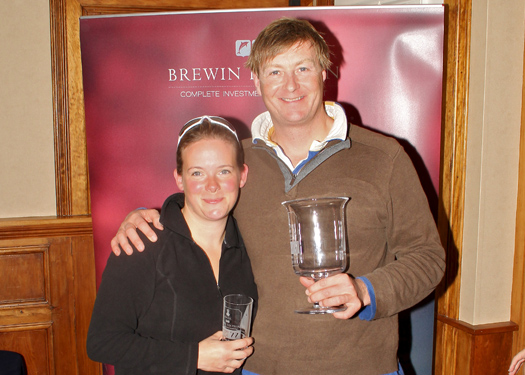
Squib Winners Greg Bell and Leah Anderson
Race Four for the Squibs gave Greg Bell his first win of the series with Des Clayton on "Inishmara" second and "Worm" third. All change again for race five this time the Anderson brothers "Born Wild" took the bullet followed by the worm and Gordon Patterson's "Quickstep" third. All was to play for in the last race as the series top three places was wide open.
In the end Sam Lyness won the race and secured him a second place overall. "Quickstep" took second giving them a fourth overall. Johnny Parks "Gizmo" finished third in that race quite satisfactory for the Squib newcomer. But the Series top spot went to Greg Bells "Prodigal" on twelve points one point ahead of "Worm" and "Toy for the Boy" third overall on 16 points.
The Commodore of Royal North Mike Vaughan thanked the sponsors Brewin Dolphin and all those who had been involved in the event, he commented on the extremely close racing in all fleets but especially in his own fleet the
Elites which were extraordinary!
Arctic Fox Beats Kerfuffle for Howth Squib Honours
Shockwave Wins SB3 Howth Race
RS Elites Add Colour to Baily Bowl Weekend
Low pressure systems played havoc with the Royal Alfred YC Baily Bowl on Dublin Bay this weekend with visitors from Belfast Lough adding much needed colour writes our Dublin Bay Correspondent. The one design fixture struggled to attract big numbers in any of the four fleets sailing and the local Flying fifteen class opted out altogether.
The one design weekend is part of the 2011 Royal Alfred Season.
Race officers Brian Reddy and Barry MacNeany succeeded in completing three races on Saturday on both race courses but 50 knot gusts on a white Dublin Bay put paid to Sunday racing entirely.
Simon Brien from Cultra sailing Kin won the six boat Dragon fleet with two firsts and a second from Richard Goodbody and the Johnson Brothers Diva. Next week the class East coast championships will be held on the bay.
Peter Wallace's Toy for the Boys took the Squib class from local Frank Whelan in Lola.
Vincent Delany, a favourite for the Squib event, didn't show his usual form in third returning twice at starts and struggling up through the fleet.
Requests for redress from the race committee after recall signal misfire were denied according to the RAYC.
Peter and Marie Dee in Kookaburra after winning race two, lost third place overall to Delany after retiring from the final race.
In the six boat RS Elite fleet which decamped from the shores of Belfast Lough, Tiffany Brien crewed by Jay Bourke tied with John Patterson in Momentary Lapse on 7 points but lost on tie break. The Laser radial sailor still beat her uncle Mark in Full Marks!
Trevor Darcy and Simon Hutchinson from Carrrickfergus in Bullet won the SB3 fleet by a point from Colin Galavan's Defiant after the fleet retired from the final race as the wind touched force six.


























